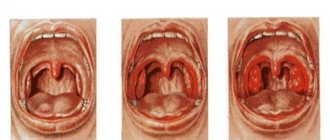Author of the article
Volyk Larisa Vladimirovna
Reading time: 6 minutes
AA
The neck is a rather vulnerable part of the human body. Naturally, various patient complaints of pain in this area are recorded by doctors quite often. It is also natural that patients, one way or another, wonder what is the cause of the pain that appears, what can be done to alleviate their own condition?
The most important thing, if you develop a feeling of pain in the throat or larynx, is to contact a specialist so that he can help determine the cause of the unpleasant symptom.
What does the symptom mean?
The appearance of an unpleasant feeling of soreness in the throat and larynx is not always a consequence of a cold, as most people are used to thinking. Yes, it is a cold that often triggers pathological processes and makes the process of swallowing painful, but you should not look for the cause only in it.
Pain in the neck and larynx is a symptom that accompanies a wide variety of diseases. This must be taken into account if the patient decides to be treated at home rather than see a doctor. Sometimes even malignant neoplasms lead to the appearance of an unpleasant symptom, which patients often forget about when trying to deal with the symptom rather than the cause of its occurrence.
Doctors do not recommend self-medication if you experience pain in the throat or larynx. This is due to a wide range of diseases that lead to the appearance of symptoms and a significant difference in approaches to their treatment. For example, pain can be provoked by the following abnormalities:
- presence of a foreign body in the throat cavity;
- injury to the spine in the cervical region or the throat itself;
- various ulcers and abscesses;
- various diseases of the circulatory system, etc.
Only four possible causes of pain were immediately named, but upon closer examination it becomes obvious that there are many more. Some factors are worth getting to know in more detail.
Infectious pathologies
Various infectious diseases are the most common cause of pain in the throat and larynx. All infectious pathologies are often accompanied by poor health, fatigue, weakness, high fever and other unpleasant symptoms, so it is not always difficult to suspect the presence of an infectious process.
Often the throat begins to hurt, for example, with a sore throat, which is also widely known today as tonsillitis. Interestingly, if the sore throat has an atypical form, then pain can be observed only on one side (mainly on the left, since the left side of the throat is more susceptible to infectious pathologies).
Sore throat can be distinguished from other infections based on temperature readings . For example, with this disease, the temperature rarely rises above 37 degrees, and sometimes it can even remain within normal limits.
Pharyngitis is another common cause of sore throat or pharynx . It is important to understand that pharyngitis itself means only an inflammatory process, but the cause of its development will have to be established separately with the help of diagnostic measures carried out by a doctor.
Pharyngitis is not always an independent disease. As a separate symptom, it can accompany, for example, influenza, ARVI, various types of pneumonia and other diseases. It is important in this case to establish the cause of pharyngitis, which will help to choose the optimal method of therapy.
An additional symptom indicating a bacterial or viral infectious process may be the appearance of mucus. The mucus usually slowly flows down the wall of the pharynx and is swallowed by the patient, causing discomfort and causing a cough.
And mushrooms grow in my mouth
In addition, doctors often encounter such throat diseases as:
- candidal stomatitis. This is a fungal disease in which small milky-white spots appear on the soft palate, back of the tongue, mucous membrane of the pharynx and larynx; infectious mononucleosis. Symptoms are swollen and reddened tonsils, covered with large yellowish-white films; herpangina (Coxsackie virus) - small blisters on the soft palate, uvula, arches, back wall of the pharynx.
In these cases, a bacterial infection can also occur, an abscess begins when the uvula moves and it becomes impossible to fully open the mouth. Symptoms of severe diphtheria infection develop. For these diseases, the doctor must also select an effective antibiotic.
Lymphadenitis
Lymphadenitis is an inflammatory reaction that occurs in the lymph nodes of the human body. Such a reaction can be a consequence of various pathological processes and lead to neck pain.
Basically, if the cervical lymph nodes become inflamed, the patient complains to his doctor that the pain causes him discomfort not in the larynx, but on the lateral surfaces. However, with significant enlargement of the lymph nodes, the pain syndrome can spread, causing greater discomfort to the patient.
There can be many reasons for the development of lymphadenitis. The most common of them are:
- oncological pathology;
- an infectious process that has penetrated the lymphatic system;
- various connective tissue lesions of the autoimmune type (arthritis, lupus);
- individual hypersensitivity to aggressive environmental factors (for example, inflammation of the lymph nodes in response to a cat scratch or certain medications);
- various pathologies of the immune system;
- ear infection;
- dental pathology, etc.
Inflammation of the lymph nodes is rarely an independent pathology. Much more often, such a reaction is a consequence of some underlying disease, in which lymphadenitis will only be a symptom of the disease.
Doctors emphasize that eliminating lymphadenitis will most likely lead to relief of pain in the neck and larynx, however, efforts should not be directed at eliminating only the symptom; it is necessary to fight the cause of the disease.
Drinking is not harmful to health
When treating pharyngitis (as well as sore throats), it is important to drink plenty of warm fluids, and in case of severe pain, it is also necessary to use painkillers - such as Nurofen or paracetamol. Antibiotics are prescribed only if a bacterial infection has occurred and, for example, tracheitis, bronchitis or laryngitis has begun.
For angina, it is necessary to use antibiotics from the very beginning of the disease. Ideally, you need to take a swab from the throat to determine the type of infection and sensitivity to antibiotics in order to immediately prescribe the most effective one.
If you do not start treating a sore throat on time, serious complications are possible that affect vital organs - kidneys, heart, joints. And sometimes, against the background of this disease, autoimmune diseases develop (scleroderma, lupus erythematosus).
Stomatitis: 6 types of disease and treatment methods
Thyroid pathologies
Everyone knows that the space in the neck is very limited, and all the anatomical structures there are very close to each other. This close location often becomes the reason why the patient develops pain in the throat or larynx if any of the thyroid diseases associated with its enlargement are detected.
The fact is that if the thyroid gland increases in size even slightly, the so-called “compression” syndrome develops. That is, the tissues of the enlarged organ put pressure on the nearest vessels and nerve trunks, which provokes a feeling of pain in the patient.
The thyroid gland is located very close to the trachea and larynx. Due to the enlargement of this organ, both adjacent formations may be compressed, which is why the patient will complain not only of pain that develops when swallowing, but also of a feeling of a constant “lump in the throat.”
Additional symptoms that will help determine that the problem lies in thyroid disease may include:
- increased discomfort on deep inspiration;
- rapid and unfounded mood swings from depression to joy and vice versa;
- various weight changes (for example, strong weight gain in a short period of time or sudden weight loss);
- strong temperature fluctuations without the presence of an infectious process;
- excessively dry skin;
- problems with the condition of the nail plates and hair.
It is important to keep in mind that thyroid pathologies are often detected at fairly late stages. This is due to the fact that until a certain moment the patient does not feel discomfort, and having felt it, he does not turn to specialists for help for a long time. Only when the thyroid gland significantly increases in size and the discomfort becomes constant does the patient go to the doctor.
It is also interesting that today it is customary to classify the so-called functional room into a separate category. With this pathology, the unpleasant sensations in the throat are not constant, but develop only against the background of stress or nervous strain.
Cuts, stabs, aches, presses?
Typically, a sore throat is permanent, worsens when swallowing, and may be the only complaint when visiting a doctor. Although it often occurs against the background of general symptoms characteristic of acute respiratory infections, such as weakness, malaise, fever, headache, runny nose.
There is a wide variety of pain in the throat - from sharp, “dagger”, stabbing, cutting to dull, aching, pressing; from bursting to pulsating or mixed, with a constant, increasing or subsiding character. The localization of pain is also different: it can hurt in the middle, on the right or left, on both sides or all over the throat.
How to cure a throat with folk remedies?
Spinal problems
Various diseases of the spine, and especially the cervical spine, can manifest themselves as pain in the larynx and directly in the neck. This is often due to a high level of stress on the cervical spine. The result is very predictable: the cervical intervertebral discs become thinner, the vertebrae themselves wear out significantly, losing their former mobility.
Against the background of wear and tear of the cervical vertebrae, a person often experiences problems not only with pain in the neck. In most cases, there may also be episodes of cerebrovascular accidents, constant tension in the neck and pharyngeal muscles, causing pain, and disturbances in the functioning of various organs.
Against the background of problems with the cervical spine, the patient may also notice a gradual loss of sensation in the upper extremities, which usually scares him most quickly. There may be complaints of numbness in the fingers and insufficient range of motion.
A variety of diseases of the cervical spine develop mainly in old age. During this period, the tissues of the human body lose the ability to fully cope with the load, which is why wear of the vertebrae develops, accompanied by the appearance of a pain symptom.
Lump in throat: what examinations are needed
As you can see, a “lump in the throat” can have different reasons, which only a specialist can understand. If discomfort in the larynx does not go away, do not hesitate to visit a general practitioner, who, if necessary, will refer you to other specialists.
“To understand what exactly we are dealing with, we have to conduct a full examination,” says Kira Mushinskaya. — It includes examination and palpation of the neck, cervical lymph nodes and thyroid gland, blood and urine tests, and an ultrasound of the thyroid gland is mandatory. The patient should also be examined by an otolaryngologist, because in addition to the above reasons, the feeling of a lump in the throat can also be caused by neoplasms of the larynx and vocal cords.
Especially if it feels like an obstacle, an obstacle inside the throat. Don’t forget about ENT diseases, for example, hypertrophied, inflamed tonsils with chronic tonsillitis, which can also be accompanied by a feeling of discomfort in the larynx.” As additional tests, you may also be asked to have an X-ray and an MRI of the cervical spine.
Our expert: therapist, family doctor Evgeniy Likunov.
Other Possible Causes
In addition to the reasons already mentioned, there are other factors that lead to the development of soreness in the throat and larynx. These reasons are somewhat less common, but they should not be excluded.
Carotidynia
Carotidynia is a pathology accompanied by inflammation of the carotid arteries. The pain mainly spreads along the side of the neck, and may intensify in response to attempts to swallow or feel the affected area.
Chondroperichondritis
Chondroperichondritis is a disease associated with damage to the cartilage involved in the formation of the larynx. Basically, not only cartilage is involved in the process, but also the nearest lymph nodes. As a result, a person feels pain when swallowing, and in some cases, if the pathological process has gone very far, it is even possible to develop suffocation.
Dental diseases
Various dental pathologies, especially affecting the 7th or 8th teeth, are often accompanied by soreness in the throat and pain when swallowing. This is explained by the close location of nerves that can be involved in the inflammatory process. In this case, the pain sometimes radiates to the ear, and can intensify when moving the jaw or trying to swallow saliva.
Paralysis
Laryngeal paralysis is a serious pathology in which there is a violation of swallowing and respiratory movements due to improper transmission of nerve impulses or the complete absence thereof. Often this disease can lead to asthma attacks.
Tumor neoplasms
The development of tumors of various types in the neck area can lead to pain in the throat and larynx. This is explained by the same symptom of compression that is observed in various diseases of the thyroid gland.
What to do if you have a sore throat
- What to do if a sore throat radiates to the ear area;
- How to treat sore throat at home;
- What does it mean if your throat hurts on only one side?
To the doctor!
Complaints of acute sore throat in elderly patients should be alarming. Nasopharyngeal cancer is a fairly common pathology today, which doctors have not yet learned how to treat effectively.
The course of this disease is extremely aggressive and its development is rapid. The prognosis depends on early diagnosis. Therefore, in no case should you endure it until it “goes away on its own.”
Another possible reason for such complaints is that older people often use dentures. And they are a source of injury, infection and atrophy of the mucous membranes. In all cases, to rule out serious illnesses and prescribe the correct treatment, it is best to see a doctor.
Sources:
- health.mail.ru
- www.jv.ru
- www.aif.ru










